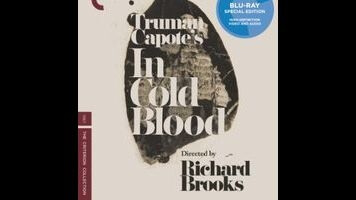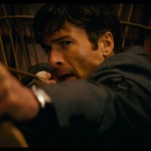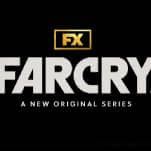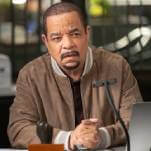The original Hollywood film noir era petered out toward the end of the 1950s, or right around the time the cinephile directors of the French New Wave started riffing on it. But well into the 1960s, noir’s expressionistic visual style remained in play for some American auteurs (such as Sam Fuller, John Frankenheimer, Sidney Lumet, and Stanley Kubrick). And even as mainstream movies turned brighter and broader, a few filmmakers kept returning to the docu-realistic storytelling that dominated noir’s waning years. Writer-director-producer Richard Brooks had more control over his projects than most who worked within the studio system, yet he wasn’t known for any particular stylistic flair. He was a mercurial filmmaker, who preferred serious, socially relevant subjects, and he adapted his work to fit its subject matter and its times—even during a decade when cinema was wildly in flux.
All of this is a way of trying to explain how Brooks’ uncommonly great 1967 adaptation of Truman Capote’s best-selling “non-fiction novel” In Cold Blood came to be. Not only was this the best film Brooks would ever make, but it’s unlike anything else coming out of Hollywood at the time—at once a throwback to the best American movies of the 1950s and on the cutting edge of what was happening and what was about to happen in world cinema. In Cold Blood has the lurid qualities of classic noir, coupled with a documentary approach that owes as much to the jittery energy of the then-burgeoning verité movement as to the “just the facts” take of older crime pictures. It features a pair of earthy method-style performances at its center, yet plays around with chronology in ways that defy audience expectations and shatter the realism. It’s a hard movie to categorize.
Robert Blake and Scott Wilson portray real-life criminals Perry Smith and Dick Hickock, who in November of 1959 entered the home of the Clutter family in a small Kansas town, and murdered all four members, after failing to find a safe they’d been told was in the house. Capote spent over six years researching and writing his book about the Clutter case, and helped pioneer what would come to be called “The New Journalism” by applying literary techniques of character-building and scene-setting to a factual account. Brooks approximated Capote’s boldness in his own way, by making a leisurely paced movie that dwells on the petty, often pathetic details of Smith and Hickock’s lives—while holding back the scenes of what actually happened to the Clutters until after the killers have been arrested. And when Brooks’ In Cold Blood does circle back around to the crime itself, the botched robbery and impulsive slaying play out in hushed darkness, making it all the more agonizing.
Criterion’s new Blu-ray edition of In Cold Blood comes at the film in the way that police detectives tackle a crime scene—cordoning it off into sections and looking for clues. Beyond a 4K digital restoration that deepens every shadow and captures every cloud in the vast Kansas sky, the disc’s main assets are its multiple featurettes, which analyze the work of four key In Cold Blood contributors: Brooks, cinematographer Conrad Hall, editor Peter Zinner, and composer Quincy Jones. (Disappointingly absent? Any discussion of the acting. Given Blake’s own legal woes, it might not have been appropriate for Criterion to get him to sit for an interview, but surely Scott Wilson can’t be too busy now that he’s no longer playing Herschel on The Walking Dead.)
Hall often gets a lot of the credit for making In Cold Blood special, as his stark lighting captured the bleakness of the story while also underscoring its poignancy—most famously, in a scene where Hall let the shadows of raindrops on a prison window serve as the tears Smith can’t shed. But the cinema scholars interviewed on the Criterion disc make just as compelling cases for the work of Zinner (who made the intense moments more gut-wrenching by speeding up the tempo, in contrast to the slower day-in-the-life scenes) and Jones (whose jazzy score, anchored by the work of Wrecking Crew bassist Carol Kaye, shatters the movie’s long silences with eerie discord).
But it’d be a mistake to deflect too much praise from Brooks, who had the savvy to fit all of those pieces together—and to commission them in the first place. Not everything Brooks tried works. He didn’t need to add the journalist character who arrives belatedly to explain what’s going on, and the hallucinatory flashbacks to Smith’s broken boyhood smack of shallow pop psychology. But it’s still unexpectedly persuasive when In Cold Blood gradually morphs into an anti-capital punishment tract—especially given that Brooks makes the scenes inside the Clutter house as suspenseful and horrifying as any Hitchcock film. Really, that’s even gutsier: to look unblinkingly at what Smith and Hickock did, and still suggest that their execution was also “in cold blood.”
Brooks shot as much as possible inside the original locations—including at the Clutter place, which is incredibly unsettling—and he hired some of the people who were involved with the case to play themselves. In Cold Blood is filled with finely observed little pieces of human behavior, such as the indifferent way a prostitute cleans herself up to have sex with Hickock, and the playfulness between the boys as they pick up their robbery supplies in a dusty hardware store. But then Brooks will throw in a jarring jump cut, or an unnerving subjective camera move, showing off an artist’s eye amid all the dogged verisimilitude. Brooks wrote his first screenplay in 1942, and directed his first movie in 1950. But in 1967, at 55 years old, he got out ahead of the “New Hollywood” with a project that uses all the state-of-the-art tricks of cinema to depict something blunt and bloody.









































